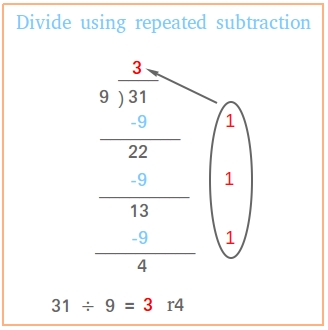Divide using repeated subtraction
Divide using repeated subtraction is what this lesson will teach you. We will show you how to do some divisions with some really good examples.
Interesting examples showing how to divide using repeated subtraction
Example #1
Divide 28 by 5
____
Write 5 ) 28
Step 1
What you need to do here is to subtract the divisor until the remainder is less than the divisor or 5. Record a 1 each time you subtract. In our example, the divisor is 5, so you will subtract 5. Note that the 1 shown in red keeps tract of the number of times you need to subtract 5.
____
5 ) 28
-5 1
________
23
-5 1
_________
18
-5 1
__________
13
-5 1
__________
8
-5 1
__________
3
Since 3 is smaller than 5, then we can stop subtracting.
Step 2
Count the number of times you subtracted the divisor or 5. Above you can see that there are 5 ones.
Therefore, 5 is subtracted 5 times and the number that is left is 3.
Therefore, 28 ÷ 5 = 5 r3
The meaning of 5 r3 is a quotient of 5 with remainder of 3.
Example #2
Divide 380 by 62
______
Write 62 ) 380
Step 1
Subtract the divisor until the remainder is less than the divisor or 62. Record a 1 each time you subtract. In our example, the divisor is 62, so you need to subtract 62. Notice again that the 1 keeps tract of the number of times you subtract 62.
______
62 ) 380
-62 1
________
318
-62 1
_________
256
-62 1
__________
194
-62 1
__________
132
-62 1
__________
70
-62 1
_________
8
8 is smaller than 62, so we stop subtracting.
Step 2
Count the number of times you subtracted the divisor or 62. Above you can see that there are 6 ones.
Therefore, 62 is subtracted 6 times with 8 left.
Therefore, 380 ÷ 62 = 6 r8
Again, the meaning of 6 r8 is a quotient of 6 with remainder of 3.
Did you have a hard time understanding the examples above? Did you not get it at all? Do you need to understand it a little deeper? Then, take a look at this figure below and study it carefully!
